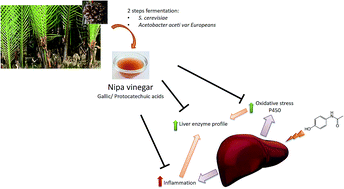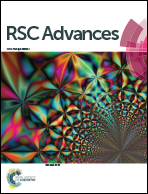Polyphenolic profiles and the in vivo antioxidant effect of nipa vinegar on paracetamol induced liver damage†
Abstract
Plant-based vinegar is proclaimed to have multiple health benefits due to the presence of polyphenol. However, not all vinegars have similar antioxidant activities. Nipa (Nypa fruticans) vinegar is one type of vinegar that has been widely consumed in Philippines and Malaysia. In this study, the antioxidant activity, polyphenolic acid profiles and antioxidant benefits to revert paracetamol-induced liver damage in mice in vivo have been evaluated. Nipa vinegar was found to contain antioxidant activity attributed to the presence of gallic acid, protocatechuic acid and 4-hydroxybenzoic acid. Continuous consumption of nipa vinegar for 14 days was able to recover the liver damage induced by paracetamol in a dosage dependent manner as indicated by the liver H&E histopathology, recovery serum liver profile (AST, ALT and ALP) and suppression of liver cytochrome P450 2E1 expression. These effects contributed to the antioxidant and anti-inflammatory effects of nipa vinegar. Similar to other types of vinegars, nipa vinegar, which is rich in polyphenolic acids, can contribute to in vivo anti-oxidation, anti-inflammation and liver protection effects in paracetamol treated mice.


 Please wait while we load your content...
Please wait while we load your content...